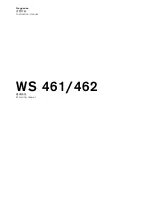
840653
75
12.7
Pressure Testing Of The Refrigeration System
The use of the in-line pressure gauge can speed up and eliminate the incorrect diagnosis of a leak within a
refrigeration system. In some cases it has been found to be the services manifold that was being used that
was leaking and not the system. There are very few parts on the in-line pressure gauge that can leak.
Rule one:
In pressure testing any cabinet, before disconnecting any joint please be 100% sure that it is not the joint
that is at fault, otherwise a lot of time can be lost looking for a joint/leak that does not exist.
Rule two:
Only use dry nitrogen to pressure test a system.
NOT REFRIGERANT OR COMPRESSED AIR.
NEVER OXYGEN
Rule three:
Don’t over pressurise the system. It can be dangerous.
12.7.1
How To Use The In-Line Pressure Gauge
Step 1:
Cut and connect the pipe circuit to be tested to the in-line pressure gauge and braze this joint.
Step 2:
At the other end of the pipe circuit being tested, crimp off the pipe with crimp off pliers and braze this end off
to totally seal the circuit.
Step 3:
Connect a nitrogen bottle to the in-line pressure gauge by means of a hose with a Schrader valve
depressing key in the hose coupling.
Step 4:
Open the nitrogen bottle fully with the regulator backed off.
Step 5:
Increase the regulator pressure in the circuit being tested to 150 psi.
Step 6:
Close the nitrogen bottle valve and back off the pressure regulator.
Step 7:
Disconnect the hose coupling to the Schrader valve fitting.
Step 8:
Seal the Schrader valve with its sealing cap.
Step 9:
Use a piece of masking tape to mark the face of the pressure gauge at the set pressure, then record the
date and time.
Step 10:
Check all exposed brazed joints with soap bubbles, including the joints on the in-line pressure gauge.
Step 11:
Allow the pipe circuit under test to sit on drop off test. This could take a number of days for a result.
NOTE: In some cases a leak may not be found by pressurising the circuit, whereas a vacuum pulled on the
same circuit will. Keep this in mind, as oil within the circuit can block a hole. Likewise, refrigerant dissolved
in the oil will boil off from within the oil over time.
In some cases, if the brazed joint is warmed while under pressure, this can thin the oil to expose the leak.
Содержание RB36S25MKIW
Страница 1: ...840653 Service Manual CoolDrawer Models RB36S25MKIW RB90S64MKIW ...
Страница 12: ...840653 12 3 4 Integrated Panel Preparation ...
Страница 14: ...840653 14 3 5 Create Cut Outs In Frame 3 6 Locate And Secure Install Brackets ...
Страница 15: ...840653 15 3 7 Attach Inlet And Outlet Vent Ducts 3 8 Attach Power Cord And Trim Brackets ...
Страница 16: ...840653 16 3 9 Move Product Into Cavity 3 10 Fit Drawer Panel Attachment Hooks ...
Страница 17: ...840653 17 3 11 Attach Drawer Panel To Front Of Drawer ...
Страница 18: ...840653 18 3 12 Secure Trim Brackets To Cabinetry 3 13 Attach Trims To Sides Of Cabinetry ...
Страница 19: ...840653 19 3 14 Attach False Panel 3 15 Check Operation ...
Страница 53: ...840653 53 11 WIRING DIAGRAMS Ω Ω Ω Ω Ω Ω Ω Ω Ω Ω ...
Страница 54: ...840653 54 ...
Страница 77: ...840653 77 ...
































